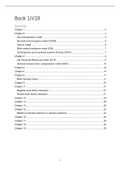Samenvatting
Summary An Introduction to Contemporary Work Psychology, ISBN: JV10 Organisational behaviour (1JV10)
- Instelling
- Technische Universiteit Eindhoven (TUE)
This document provides a summary of almost all chapters of the book "An Introduction to Contemporary Work Psychology" used in the course 1JV10. At the end of the document, slides from the last lecture of the course state what topics you should know for the exam.
[Meer zien]





